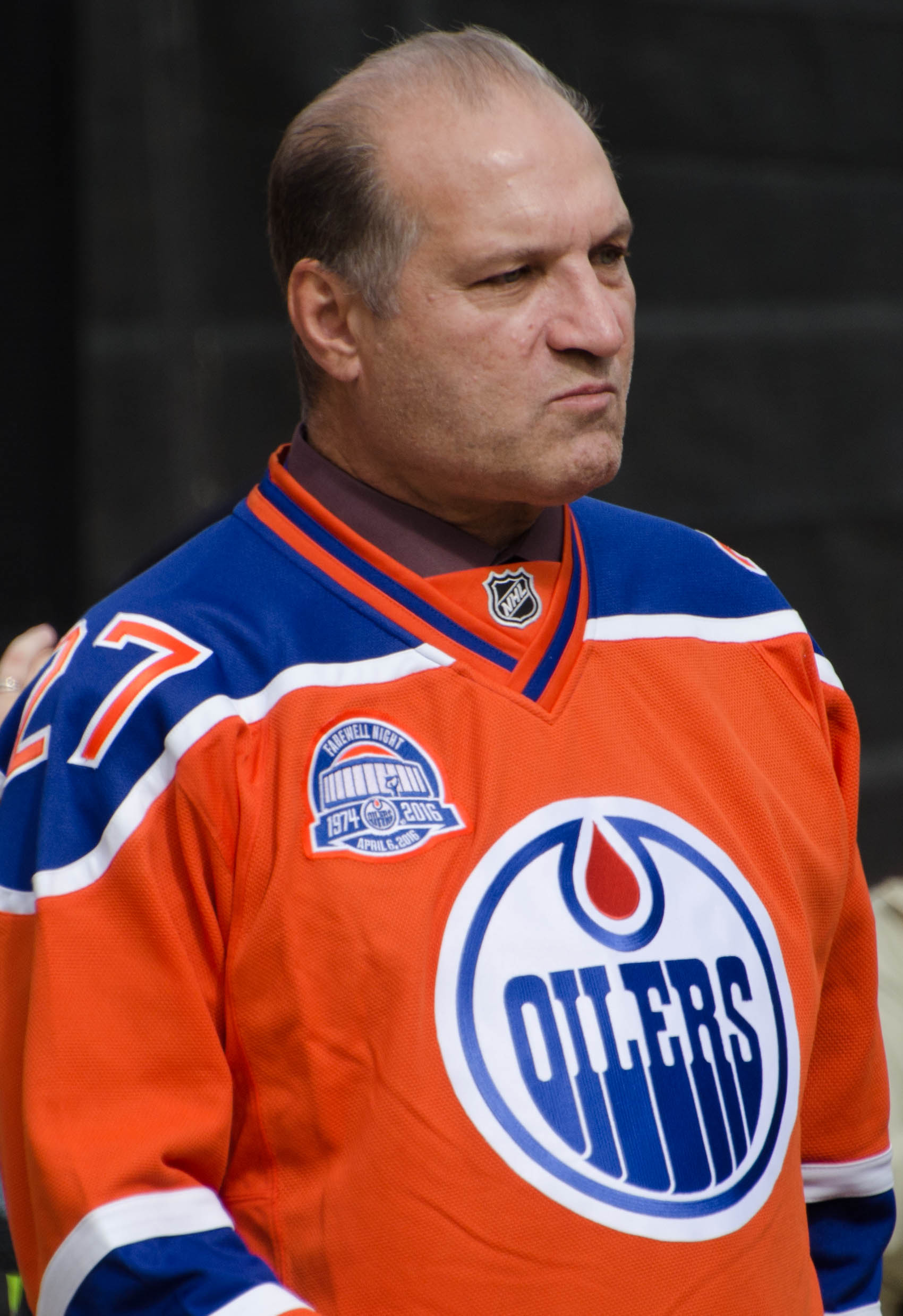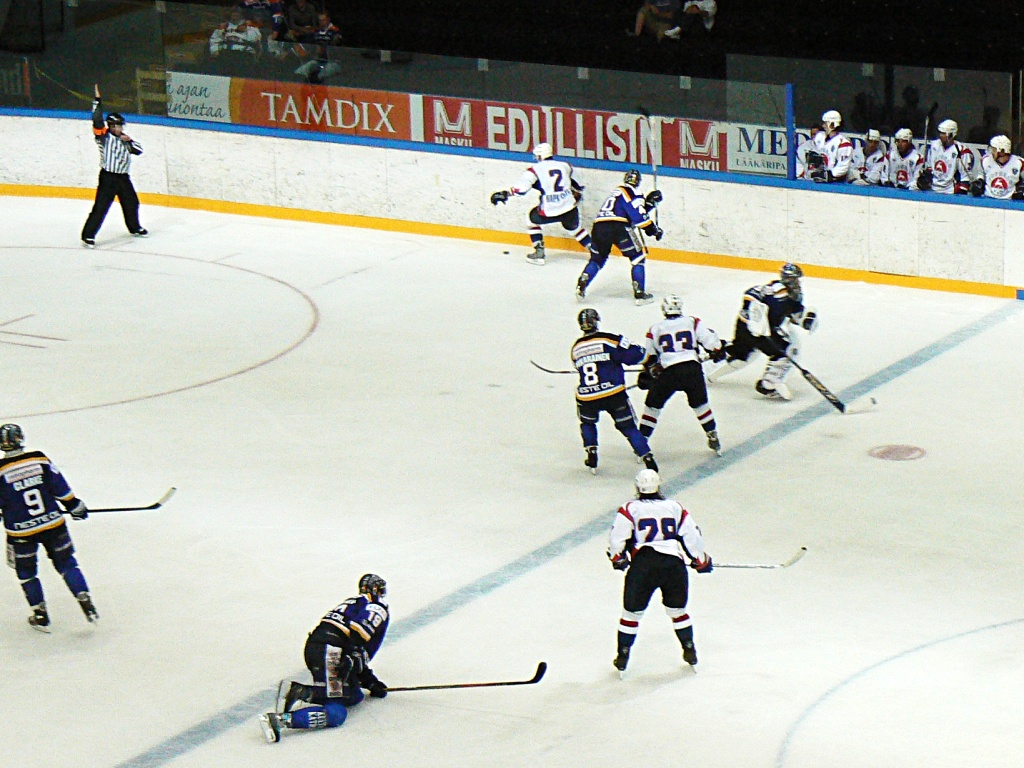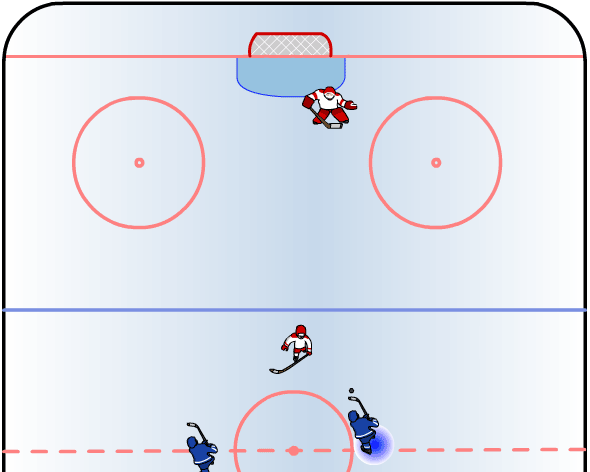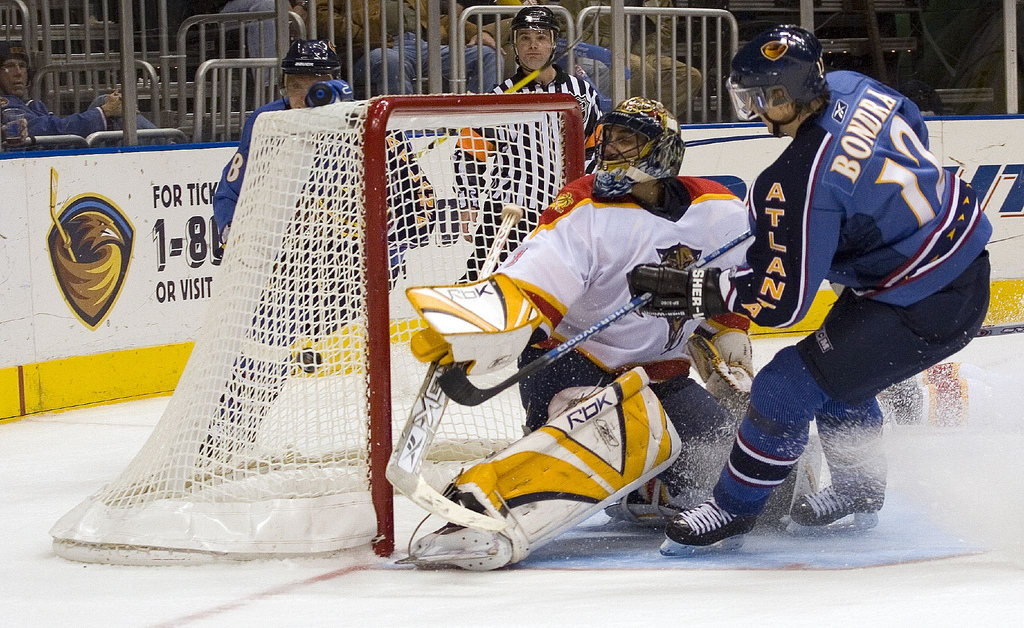|
Sami Helenius
Sami "Helge" Helenius (born January 22, 1974) is a Finnish former professional ice hockey defenceman who played predominantly in the SM-liiga and National Hockey League. He most recently was in a coaching role with Haukat of the Suomi-sarja. Playing career Helenius was drafted by the Calgary Flames as their fifth-round pick, 102nd overall, in the 1992 NHL Entry Draft. He started his professional career in Jokerit in the Finnish SM-liiga in 1992, and made his way to North America for the 1994–95 season, and after spending five years mostly in the minor leagues, Helenius took his place as an NHL defenceman, playing for several teams. Helenius became known as the "Fighting Finn," as he was one of the few Europeans to play in an enforcer role in North-American hockey leagues. In 2003, he returned to Finland to play in the SM-liiga again. After a year with Jokerit where he served as team captain, Helenius represented both Ilves and Pelicans before returning to Jokerit after the 2006 ... [...More Info...] [...Related Items...] OR: [Wikipedia] [Google] [Baidu] |
Jokerit
Helsingin Jokerit (English: Jokers or Jesters) are a professional ice hockey team based in Helsinki, Finland. The team won six league championships as a member of the Finnish SM-liiga (1973, 1992, 1994, 1996, 1997, and 2002). Jokerit plays its home games at Helsinki Halli. The team was a part of the Bobrov Division of the Kontinental Hockey League (KHL) Western Conference from the 2014–15 season, making Finland the first Nordic country to have a team in the league. On February 24, 2022, Jokerit announced it would withdraw from the 2022 KHL playoffs due to the Russian invasion of Ukraine. Multiple team sponsors including the arena's title sponsor Hartwall announced intentions to end their agreements. On April 5, 2022, Jokerit subsequently announced ending their participation in the KHL completely. And on April 20, 2022, they announced that they are seeking to return to SM-liiga for the 2023–24 season. History The beginning Jokerit would not have existed without the debt- ... [...More Info...] [...Related Items...] OR: [Wikipedia] [Google] [Baidu] |
Enforcer (ice Hockey)
Enforcer is an unofficial role in ice hockey. The term is sometimes used synonymously with "fighter", "tough guy", or "goon". An enforcer's job is to deter and respond to dirty or violent play by the opposition. When such play occurs, the enforcer is expected to respond aggressively, by fighting or checking the offender. Enforcers are expected to react particularly harshly to violence against star players or goalies. Enforcers are different from pests, players who seek to agitate opponents and distract them from the game, without necessarily fighting them. The pest's primary role is to draw penalties from opposing players, thus "getting them off their game", while not actually intending to fight the opposition player (although exceptions to this do occur). Pests and enforcers often play together on the same line, usually the fourth line. National Hockey League At present in the National Hockey League (NHL), teams generally do not carry more than one player whose primary role is ... [...More Info...] [...Related Items...] OR: [Wikipedia] [Google] [Baidu] |
I-Divisioona ...
I-Divisioona was the second tier of ice hockey in Finland from 1974 to 2000. In the year 2000 I-Divisioona was replaced by Mestis. Participating teams External linksFinnish Ice Hockey Federation {{DEFAULTSORT:1-Divisioona Ice hockey leagues in Finland Defunct ice hockey competitions in Finland Fin A fin is a thin component or appendage attached to a larger body or structure. Fins typically function as foils that produce lift or thrust, or provide the ability to steer or stabilize motion while traveling in water, air, or other fluids. Fin ... [...More Info...] [...Related Items...] OR: [Wikipedia] [Google] [Baidu] |
1992–93 I-Divisioona Season
The 1992–93 I-Divisioona season was the 19th season of the I-Divisioona, the second level of Finnish ice hockey. 12 teams participated in the league, and JoKP Joensuu won the championship. KooKoo, TuTo Hockey, and JoKP Joensuu qualified for the SM-liiga promotion/relegation round. Regular season External links Finnish Ice Hockey Federation {{DEFAULTSORT:1992-93 I-Divisioona season 2 Fin A fin is a thin component or appendage attached to a larger body or structure. Fins typically function as foils that produce lift or thrust, or provide the ability to steer or stabilize motion while traveling in water, air, or other fluids. Fin ... I-Divisioona seasons ... [...More Info...] [...Related Items...] OR: [Wikipedia] [Google] [Baidu] |
1992–93 SM-liiga Season
The 1992–93 SM-liiga season was the 18th season of the SM-liiga, the top level of ice hockey in Finland. 12 teams participated in the league, and TPS Turku won the championship. Standings Playoffs Quarterfinals * TPS - Ilves 3:1 (6:0, 5:4 P, 1:3, 4:3) * Jokerit - Ässät 0:3 (6:7, 2:3, 3:4 P) * HIFK - JYP 1:3 (2:4, 2:5, 4:1, 1:4) * HPK - Lukko 3:0 (2:0, 4:3, 3:1) Semifinals * TPS - Ässät 3:1 (6:3, 1:4, 6:3, 6:0) * HPK - JYP 3:2 (6:3, 0:1, 4:1, 1:2, 2:1) 3rd place * JYP - Ässät 4:3 Final * TPS - HPK 3:1 (9:3, 5:6, 3:2, 3:1) Relegation External links SM-liiga official website {{DEFAULTSORT:1992-93 SM-liiga season 1992–93 in Finnish ice hockey Fin A fin is a thin component or appendage attached to a larger body or structure. Fins typically function as foils that produce lift or thrust, or provide the ability to steer or stabilize motion while traveling in water, air, or other fluids. Fin ... Liiga seasons ... [...More Info...] [...Related Items...] OR: [Wikipedia] [Google] [Baidu] |
Penalty (ice Hockey)
A penalty in ice hockey is a punishment for an infringement of the rules. Most penalties are enforced by sending the offending player to a penalty box for a set number of minutes. During the penalty the player may not participate in play. Penalties are called and enforced by the referee, or in some cases, the linesman. The offending team may not replace the player on the ice (although there are some exceptions, such as fighting), leaving them short-handed as opposed to full strength. When the opposing team is said to be on a ''power play'', they will have one more player on the ice than the short-handed team. The short-handed team is said to be "on the penalty kill" until the penalty expires and the penalized player returns to play. While standards vary somewhat between leagues, most leagues recognize several common varieties of penalties, as well as common infractions. The statistic used to track penalties is called "penalty minutes" and abbreviated to "PIM" (spoken as single w ... [...More Info...] [...Related Items...] OR: [Wikipedia] [Google] [Baidu] |
Point (ice Hockey)
In ice hockey, point has three contemporary meanings. Personal stat A point is awarded to a player for each goal scored or assist earned. The total number of goals plus assists equals total points. The Art Ross Trophy is awarded to the National Hockey League (NHL) player who leads the league in scoring points at the end of the regular season. Team stat Points are also awarded to assess standings (or rankings). Historically, teams were awarded two points for each win, one point for each tie and no points for a loss. Such a ranking system, implemented primarily to ensure a tie counted as a "half-win" for each team in the standings, is generally regarded as British and/or European in origin and as such adopted by the National Hockey League which was founded in Canada where leagues generally used ranking systems of British origin. Awarding points in the standings contrasts with traditional American ranking systems favored in sports originating within the United States where today the m ... [...More Info...] [...Related Items...] OR: [Wikipedia] [Google] [Baidu] |
Assist (ice Hockey)
In ice hockey, an assist is attributed to up to two players of the scoring team who shot, passed or deflected the puck towards the scoring teammate, or touched it in any other way which enabled the goal, meaning that they were "assisting" in the goal. There can be a maximum of two assists per goal. The assists will be awarded in the order of play, with the last player to pass the puck to the goal scorer getting the primary assist and the player who passed it to the primary assister getting the secondary assist. Players who gain an assist will get one point added to their player statistics. Despite the use of the terms "primary assist" and "secondary assist", neither is worth more than the other, and neither is worth more or less than a goal. Assists and goals are added together on a player's scoresheet to display that player's total points. Special cases If a player scores off a rebound given up by a goaltender, assists are still awarded, as long as there is no re-possession by t ... [...More Info...] [...Related Items...] OR: [Wikipedia] [Google] [Baidu] |
Goal (ice Hockey)
In ice hockey, a goal is scored when the puck entirely crosses the goal line between the two goal posts and below the goal crossbar. A goal awards one point to the team attacking the goal scored upon, regardless of which team the player who actually deflected the puck into the goal belongs to (see also own goal). Typically, a player on the team attempting to score shoots the puck with their stick towards the goal net opening, and a player on the opposing team called a goaltender tries to block the shot to prevent a goal from being scored against their team. The term goal may also refer to the structure in which goals are scored. The ice hockey goal is rectangular in shape; the front frame of the goal is made of steel tube painted red (blue in the ECHL because of a sponsorship deal with GEICO) and consists of two vertical goalposts and a horizontal crossbar. A net is attached to the back of the frame to catch pucks that enter the goal and also to prevent pucks from entering it ... [...More Info...] [...Related Items...] OR: [Wikipedia] [Google] [Baidu] |
Season (sports)
In an organized sports league, a typical season is the portion of one year in which regulated games of the sport are in session: for example, in Major League Baseball the season lasts approximately from the last week of March to the last week of September. In other team sports, like association football or basketball, it is generally from August or September to May although in some countries - such as Northern Europe or East Asia - the season starts in the spring and finishes in autumn, mainly due to weather conditions encountered during the winter. A year can often be broken up into several distinct sections (sometimes themselves called seasons). These are: a preseason, a series of exhibition games played for training purposes; a regular season, the main period of the league's competition; the postseason, a playoff tournament played against the league's top teams to determine the league's champion; and the offseason, the time when there is no official competition. Preseason In ... [...More Info...] [...Related Items...] OR: [Wikipedia] [Google] [Baidu] |
Playoffs
The playoffs, play-offs, postseason or finals of a sports league are a competition played after the regular season by the top competitors to determine the league champion or a similar accolade. Depending on the league, the playoffs may be either a single game, a series of games, or a tournament, and may use a single-elimination system or one of several other different playoff formats. Playoff, in regard to international fixtures, is to qualify or progress to the next round of a competition or tournament. In team sports in the U.S. and Canada, the vast distances and consequent burdens on cross-country travel have led to regional divisions of teams. Generally, during the regular season, teams play more games in their division than outside it, but the league's best teams might not play against each other in the regular season. Therefore, in the postseason a playoff series is organized. Any group-winning team is eligible to participate, and as playoffs became more popular they were ... [...More Info...] [...Related Items...] OR: [Wikipedia] [Google] [Baidu] |
Regular Season
In an organized sports league, a typical season is the portion of one year in which regulated games of the sport are in session: for example, in Major League Baseball the season lasts approximately from the last week of March to the last week of September. In other team sports, like association football or basketball, it is generally from August or September to May although in some countries - such as Northern Europe or East Asia - the season starts in the spring and finishes in autumn, mainly due to weather conditions encountered during the winter. A year can often be broken up into several distinct sections (sometimes themselves called seasons). These are: a preseason, a series of exhibition games played for training purposes; a regular season, the main period of the league's competition; the postseason, a playoff tournament played against the league's top teams to determine the league's champion; and the offseason, the time when there is no official competition. Preseason In ... [...More Info...] [...Related Items...] OR: [Wikipedia] [Google] [Baidu] |





